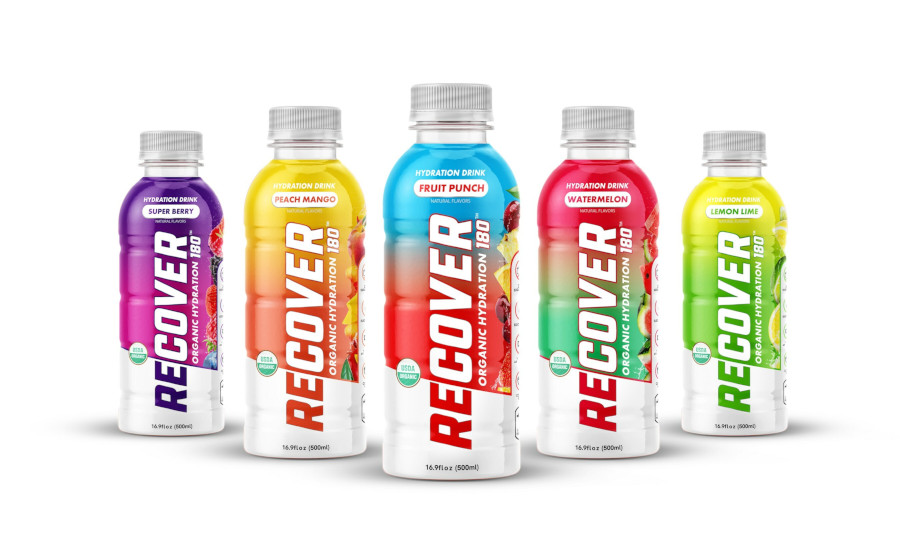Sports recovery, bone and joint health beverages appeal to all consumers, not just athletes
Beverage-makers work to deliver benefits to health-conscious consumers

Image courtesy of Getty Images
In the fantasy series “Throne of Glass,” the young Aelin Ashryver Galathynius learns to master her Fae magic in order to save the world. Her magic mainly comes in the form of fire wielding, but Aelin also possesses water and moon-fire abilities. Often describing her magic as a well that she can dig into and feel the bottom of, Aelin at times uses too much of her magic at once and is forced to recover.
Although not as entertaining as magical powers, consumers who are recovering from athletic activities are turning to beverages to support their betterment.
Cuie Yan, Ph.D., vice president of encapsulation at Blue California, Rancho Santa Margarita, CA, describes the sports recovery market as thriving, noting that it is witnessing “remarkable growth” attributed to an increased emphasis on post-exercise recuperation.
“Consumers actively seek innovative solutions beyond traditional recovery methods, driving the demand for advanced formulations that optimize muscle recovery and overall well-being,” Yan explains.
She makes the connection between sports recovery and the concept of fitness as a lifestyle.
“More individuals are adopting fitness as an integral part of their daily lives, and the demand for sophisticated recovery strategies has intensified,” Yan says.
Bret Barhoover, category marketing manager for specialty nutrition for Minneapolis-based Cargill, states that the active nutrition beverage space is strong and growing.
“In many cases, it’s some of the newer brands that are leading the charge, with double- or even triple-digit volume sales growth,” he says. “Sports nutrition/recovery RTD (ready-to-drink) shakes and powders are doing especially well, attracting a broader based of consumers with new flavors and very lower-sugar options.”
Barhoover notes that taste is a huge driver and a lever that emerging brands are pulling to set their products apart from others.
“As a result, you’ll see products with zero grams of added sugar, but they’ll be sweetened with stevia to deliver the great taste consumers expect,” he explains. “Many of the fastest-growing brands are also going beyond the classic chocolate and vanilla flavors to entice consumers with more indulgent, often dessert-inspired options as a post-workout reward.”
Barhoover also describes how more and more consumers are striving to live healthier lives and making conscious decisions about their health.
“What’s driving growth in [the] active nutrition category isn’t just the hardcore athlete; successful brands are tapping into a more mainstream consumer who wants to make better nutritional choices,” he says.
Vaughn DuBow, global director of marketing for microbiome solutions at ADM, Chicago, shares similar thoughts regarding the everyday consumer and sports nutrition.

“The sports recovery market is rapidly garnering attention from broader food and beverage brands and general consumers,” he says. “This comes at a time when the active nutrition category is growing, welcoming people beyond elite athletes that are looking to lead an active lifestyle. These consumers recognize the importance of recovery following fitness … and how products targeting recovery can support long-term wellness goals.”
He expresses that recovery is a growing area of opportunity for the beverage market, in part due to the hydration association with beverages. DuBow suggests that there will be continued interest in rapid hydration products as the space expands.
Taking in the influences
Aside from health and fitness, a plethora of trends are contributing to the sports recovery market.
Linda May-Zhang, Ph.D., vice president of science and innovation at Blue California, describes the market as being shaped by consumer preferences for ingredients that are clean and scientifically backed, and those supported by clinical studies.
“The trend focuses on products that enhance recovery by counteracting oxidative stress and inflammation, reducing performance anxiety and boosting immunity,” she says. “The demographic shift toward more active women in sports, as well as increased demands for sustainable, yet intriguing flavors that elevate mood, shape the market’s evolution.”
Similarly, Blue California’s Yan observes that consumers are gravitating toward solutions that are personalized and science-backed.
“The trend emphasizes the importance of innovative ingredients and delivery methods that enhance the efficiency of sports recovery formulations,” she says. “Microencapsulation of amino acids stands out as a key trend, addressing taste, solubility and bioavailability challenges to elevate the overall performance of recovery beverages.”
ADM’s DuBow points to the rising focus on the gut microbiome as a factor aiding in the popularity of active nutrition and sports recovery categories.
“There is ongoing research demonstrating connections between gut microbiome-supporting solutions and muscle growth and recovery, or the ‘gut-muscle axis,’” he states. “As this area continues to be explored, there are promising science-backed opportunities to further move sports recovery offerings into the limelight.”
Cargill’s Barhoover says that protein, sugar reduction, convenience and drinkability are all important to consumers as well.
“Sugar reduction is prevalent across the food and beverage landscape, but it’s especially strong in the active nutrition space,” he notes. “Consumers expect these drinks to have a lot of protein, but not a lot of sugar or calories. Sweeteners like stevia enable brands to create low and no-sugar-added formulations, yet still deliver on taste.”
He also explains that consumers are looking for beverages that deliver easy, portable, on-the-go nutrition, and believes that sports recovery beverages are “perfectly aligned” with such demands.
Finding the right formulations
As beverage-makers look to align products with consumers’ sports recovery needs, ingredient suppliers are dedicating resources to hit that range of need states.
Kyle Krause, regional product manager for functional fibers and carbohydrates at BENEO, Parsippany, NJ, call attention to the company’s isomaltulose solution.
“BENEO’s Palatinose (isomaltulose) is used globally in the performance beverage market,” he says. “It’s naturally sourced from sugar beet and is also found in honey. It has a mild, natural sweet taste (half as sweet as sucrose) and leaves no aftertaste.”
Krause explains that Palatinose, unlike conventional sugar, takes up to two hours to become fully digested and causes no sharp rise or fall in blood sugar levels, eliminating the “sugar spike and crash” effect caused by high-glycemic sugars.
“Palatinose is also an excellent carbohydrate for recovery,” he continues. “Carbohydrates can replenish glycogen stores for the next training or competition as part of an extended recovery.”
Blue California’s May-Zhang states that formulators are innovating with natural ingredients, proteins and nutrients such as amino acids, vitamins and caffeine, all of which target certain recovery benefits.
“Brands are increasingly looking for distinctive specialty ingredients for their unique health-promoting properties,” she says. “Prime examples are Blue California’s ErgoActive ergothioneine and L-TeaActive L-theanine, which are nature-inspired ingredients that can enhance athletic recovery.”
May-Zhang describes ErgoActive ergothioneine as an amino acid that “mitigates oxidative stress and inflammation” associated with rigorous physical activities, so it facilitates a quicker recovery and reduces muscle damage.
ADM’s DuBow considers beverages to be a convenient, ideal vehicle for active nutrition offerings.
“Beverage-makers that can capitalize on the increasing emphasis on electrolytes will find that their offerings resonate greatly with Generation Z,” he says. “In fact, our research shows that product labels that reference electrolytes are the most sought-out claim by younger consumers. This points to the emerging surge in rapid-rehydration beverages, as active nutrition consumers look to replenish electrolytes, fluids and energy following physical activity and throughout their day.”
Again, DuBow says that protein and gut-microbiome supporting solutions are capturing consumer attention.
“Protein also continues to be a vital part of active nutrition, particularly when considering muscle growth and recovery,” he notes. “In addition to the ongoing use of whey, beverage-makers are progressively incorporating plant proteins like soy and pea to diversify protein sources and build in more protein content. We’re supporting beverage performance brands in expanding their protein sources with our clean-tasting pea and soy proteins, which can meet the demand for nutrient-dense, high protein RTD shakes, while also ensuring an optimal sensory experience for everyday enjoyment.”
The team at Cargill shares similar thoughts.
Melissa Machen, principal technical account manager for protein ingredients at Cargill, expresses the appeal around proteins in sports recovery. She says that, while proteins figure prominently in many sports recovery beverages, achieving the high inclusion rates demanded by athletes can be a challenge, especially when brands turn to plant proteins. This can cause brands to run into two hurdles: flavor and solubility.
“On the flavor side, formulators often struggled to manage their grassy, beany and earthy off-flavors,” Machen says. “Adding to the challenge, plant proteins typically had more limited solubility, which resulted in beverages with gritty mouthfeels and sediment on the bottom. Our joint venture partner PURIS tackled these challenges head-on, leveraging advances in processing technology to create PURIS 2.0, which offers enhanced solubility and an improved sensory profile.”
Additionally Barhoover says that sugar reduction is another formulation challenge.
“Stevia sweeteners are great tools in optimizing taste while delivering healthy and label-friendly products,” he explains. “For example, our newest sweetener system, EverSweet stevia sweetener + ClearFlo natural flavor, can help address the flavor challenges associated with performance beverages.”
Beverages for bone and joint health
Beverage-makers also are turning to other formulations when creating products that offer bone and joint health.
BENEO’s Krause notes that bone minerals, mainly calcium ensure the compressive strength of bones.
“Stronger bones are characterized by an increased bone mineral density due to higher calcium absorption that reaches the bones,” he explains. “Prebiotic chicory root fibers, such as BENEO’s Orafti Synergy1, increase the absorption of calcium from the diet. More calcium is stored in the bones and contributes to their strength.”
The chicory root fiber ingredient Orafti Synergy1 nourishes a healthy gut flora, which Krause says is the basis for many health benefits, including digestive health, immune health and overall well-being.
“Orafti Synergy1 can be used in RTDs and powder beverages, and allows structure/function claims referring to bone health to be made on pack,” he adds.
Blue California’s May-Zhang says that the market is witnessing substantial growth, driven by an aging population and increased awareness of preventative health measures.
“Within the beverage sector, this trend presents a unique opportunity for functional drinks to offer tangible health benefits,” she states. “The integration of bone and joint health nutraceutical ingredients into beverage formulations is an innovative way for consumers to support their skeletal health through their daily hydration choices.”
May-Zhang also notes that the approach aligns with the growing demand for health-centric beverages.
ADM’s DuBow’s thoughts are coinciding. He says that, similar to the sports recovery market, consumers are increasingly taking a preventative mindset.
“Women, in particular, are aware that bone density declines with age, especially during the stages of menopause,” DuBow states. “Beverage-makers can turn to solutions like our Novasoy, which consist of soy isoflavones and may help maintain healthy bones following the transition into menopause.
Body composition also can have a large affect on bone and joint health, he says, and ADM’s research found that microbial strains can support overall body composition.
“To support these factors, we leverage our BPL1 probiotic and postbiotic, which target factors relevant to metabolic health,” DuBow says. “Emerging and in vitro evidence suggests that BPL1 — in combination with diet and exercise — may help support weight management, a healthy body mass index (BMI) and metabolic health pathways.”
May-Zhang says that vitamin K2 has gained attention in bone and health formulations for its role in calcium metabolism, directing calcium to the bones to enhance bone strength and promote joint health.
“Blue California offers both vitamin K2 MK-4 and MK-7 versions,” she notes. “Similarly, ErgoActive ergothioneine presents itself as a unique ingredient for these formulations, offering antioxidant and anti-inflammatory properties that are important for maintaining bone and joint health.”
Looking for a reprint of this article?
From high-res PDFs to custom plaques, order your copy today!






